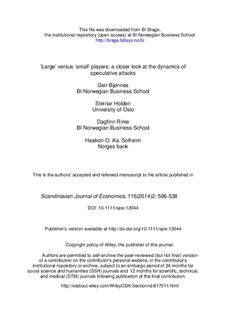| dc.contributor.author | Bjønnes, Geir Høidal | |
| dc.contributor.author | Holden, Steinar | |
| dc.contributor.author | Rime, Dagfinn | |
| dc.contributor.author | Solheim, Haakon O. Aa | |
| dc.date.accessioned | 2014-11-19T16:08:25Z | |
| dc.date.accessioned | 2014-11-21T12:58:36Z | |
| dc.date.available | 2014-11-19T16:08:25Z | |
| dc.date.available | 2014-11-21T12:58:36Z | |
| dc.date.issued | 2014 | |
| dc.identifier.citation | Scandinavian Journal of Economics, 116(2014)2: 506-538 | nb_NO |
| dc.identifier.issn | 0347-0520 | |
| dc.identifier.issn | 1467-9442 | |
| dc.identifier.uri | http://hdl.handle.net/11250/226311 | |
| dc.description | This is the authors’ accepted and refereed manuscript to the article. LOCKED until 2016-03-01 due to copyright restrictions | nb_NO |
| dc.description.abstract | What is the role of “large players” (e.g., hedge funds) in speculative attacks? Recent work suggests that large players move early to induce smaller agents to attack. However, many observers argue that large players move late in order to benefit from interest-rate differentials. We propose a model in which large players can do both. Using data on currency trading by foreign (large) and local (small) players, we find that foreign players moved last in three attacks on the Norwegian krone during the 1990s. During the attack on the Swedish krona after the Russian moratorium in 1998, foreign players moved early. Gains by delaying attack were small, however, because interest rates did not increase. | nb_NO |
| dc.language.iso | eng | nb_NO |
| dc.publisher | Wiley | nb_NO |
| dc.title | 'Large' versus 'Small' Players: A Closer Look at the Dynamics of Speculative Attacks | nb_NO |
| dc.type | Journal article | nb_NO |
| dc.type | Peer reviewed | nb_NO |
| dc.date.updated | 2014-11-19T16:08:25Z | |
| dc.source.journal | Scandinavian Journal of Economics | nb_NO |
| dc.identifier.doi | 10.1111/sjoe.12044 | |
| dc.identifier.cristin | 988105 | |
| dc.description.localcode | 2, Forfatterversjon | nb_NO |
